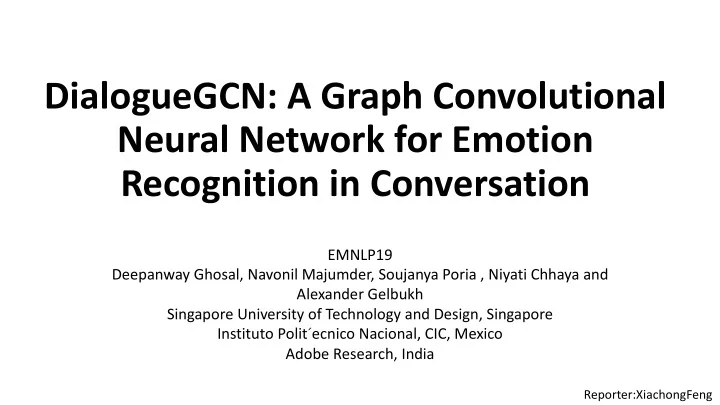

DialogueGCN: A Graph Convolutional Neural Network for Emotion Recognition in Conversation EMNLP19 Deepanway Ghosal, Navonil Majumder, Soujanya Poria , Niyati Chhaya and Alexander Gelbukh Singapore University of Technology and Design, Singapore Instituto Polit ´ ecnico Nacional, CIC, Mexico Adobe Research, India Reporter:XiachongFeng
Authors Deepanway Ghosal Research fellow in the School of Computer Science & Engineering at NTU Singapore
Emotion recognition in conversation (ERC) https://ai.baidu.com/tech/nlp/emotion_detection
Emotion recognition in conversation (ERC) https://www.leiphone.com/news/201805/gRJ1UqPmoCpfHPVL.html
Core Idea • Leverage self and inter-speaker dependency of the interlocutors to model conversational context for emotion recognition.
Model • Context Independent Utterance-Level Feature Extraction • Single convolutional layer followed by max-pooling and a fully connected layer • This network is trained at utterance level with the emotion labels. 𝑥 " 𝑥 # 𝑥 $ Convolutional utterance level Max pooling Glove Glove Glove emotion label FFNN Utterance Feature
DialogueGCN
Sequential Context Encoder Note : speaker agnostic context-independent sequential context-aware
Speaker-Level Context Encoding : vertex Each utterance in the conversation is represented as a vertex Each vertex is initialized with the corresponding sequentially encoded feature vector
Speaker-Level Context Encoding : edge • Keeping a past context window size of p and a future context window size of f . (=10) …… U1 U2 U3 Ut-1 Ut Un-2 Un-1 Un …… 10 10
Speaker-Level Context Encoding : edge • Graph is directed, two vertices can have edges in both directions with different relations • Relations:
Speaker-Level Context Encoding : transformation
Classification number of samples/dialogues L2-regularization number of utterances in sample
Dataset • IEMOCAP : happy, sad, neutral, angry, excited, and frustrated. • AVEC : valence ([−1,1]), arousal ([−1,1]), expectancy ([−1,1]), and power ([0,∞)). • MELD : anger, disgust, sadness, joy, surprise, fear or neutral.
Result
Result-MELD 1. Multiparty conversations 2. Utterances in MELD are much shorter and rarely contain emotion specific expressions, which means emotion modelling is highly context dependent. 3. The average conversation length is 10 utterances, with many conversations having more than 5 participants. • Result : new state-of-the-art F1 score of 58.10% outperforming DialogueRNN by more than 1%.
Result-Ablation
Result-Ablation
Result-Performance on Short Utterances Emotion of short utterances, like “okay”, “yeah”, depends on the context it appears in.
Result-Error Analysis • Frustrated --> angry and neutral • Excited samples as happy and neutral • [subtle difference between two emotions] • Ok. yes carrying non-neutral emotions were misclassified as we do not utilize audio and visual modality in our experiments.
Thanks!
Recommend
More recommend